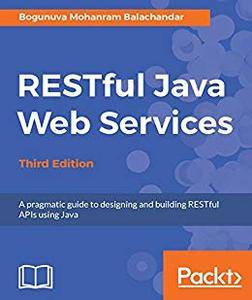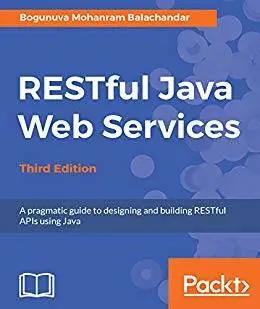RESTful Java Web Services - Third Edition: A pragmatic guide to designing and building RESTful APIs using Java by Bogunuva Mohanram Balachandar
English | 17 Nov. 2017 | ISBN: 1788294041 | 420 Pages | EPUB | 2.44 MB
English | 17 Nov. 2017 | ISBN: 1788294041 | 420 Pages | EPUB | 2.44 MB
Build efficient and secure RESTful web APIs in Java..
Design solutions to produce, consume and visualize RESTful web services using WADL, RAML, and Swagger
Familiarize the role of RESTful APIs usage in emerging technology trends like Cloud, IoT, Social Media.
Book Description
Representational State Transfer (REST) is a simple yet powerful software architecture style to create lightweight and scalable web services. The RESTful web services use HTTP as the transport protocol and can use any message formats, including XML, JSON(widely used), CSV, and many more, which makes it easily inter-operable across different languages and platforms.
This successful book is currently in its 3rd edition and has been used by thousands of developers. It serves as an excellent guide for developing RESTful web services in Java.
This book attempts to familiarize the reader with the concepts of REST. It is a pragmatic guide for designing and developing web services using Java APIs for real-life use cases following best practices and for learning to secure REST APIs using OAuth and JWT. Finally, you will learn the role of RESTful web services for future technological advances, be it cloud, IoT or social media.
By the end of this book, you will be able to efficiently build robust, scalable, and secure RESTful web services using Java APIs.
What you will learn
Introduce yourself to the RESTful software architectural style and the REST API design principles
Make use of the JSR 353 API, JSR 374 API, JSR 367 API and Jackson API for JSON processing
Build portable RESTful web APIs, making use of the JAX-RS 2.1 API
Simplify API development using the Jersey and RESTEasy extension APIs
Secure your RESTful web services with various authentication and authorization mechanisms
Get to grips with the various metadata solutions to describe, produce, and consume RESTful web services
Understand the design and coding guidelines to build well-performing RESTful APIs
See how the role of RESTful web services changes with emerging technologies and trends
About the Author
Bogunuva Mohanram Balachandar works as associate director for a leading American multinational corporation, listed in NASDAQ-100, that provides digital, technology, consulting, and operations services. He has extensive experience in the design and development of multiple enterprise application integration projects, using various tools and technologies such as Oracle SOA Suite, Oracle Service Bus, Oracle AIA, IBM WebSphere Process Server, web services, RESTful services, Business Process Execution Language (BPEL), IBM WebSphere MQ, TIBCO EMS, Java, JMS, and Spring Integration.
He is certified in SOA, web services, and cloud technologies and has over 16 years of IT industry experience in software design and development. Prior to joining his current employer, he worked with IBM, Accenture, and Wipro.
Balachandar, in his current role, is responsible for designing the integration landscape for a leading bank.
Balachandar currently lives in London, UK with his wife, Lakshmi, and daughters, VeenaSri and NavyaSree.
Table of Contents
Introducing RESTful Architecture
Java APIs for JSON Processing
Introducing JAX-RS API
Advanced Features in JAX-RS API
Introducing JAX-RS Implementation Framework Extensions
Securing RESTful Web Services
Description and Discovery of RESTful Web Services
RESTful API Design Guidelines
RESTful Services Role in Emerging Technologies
Useful Features and Techniques



